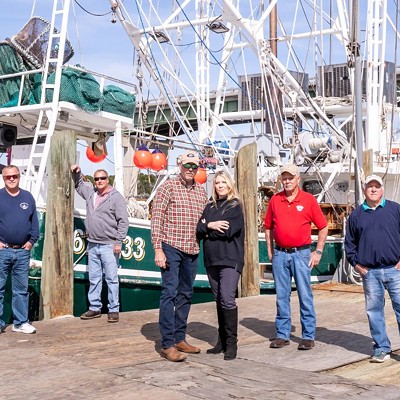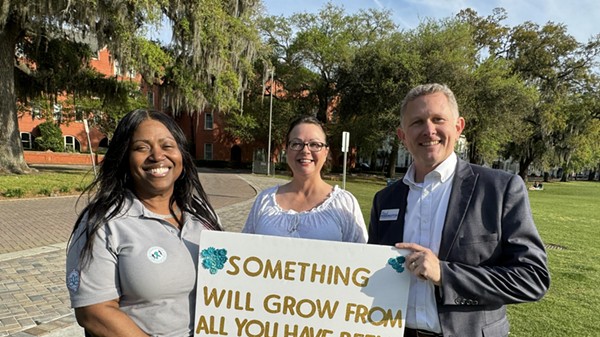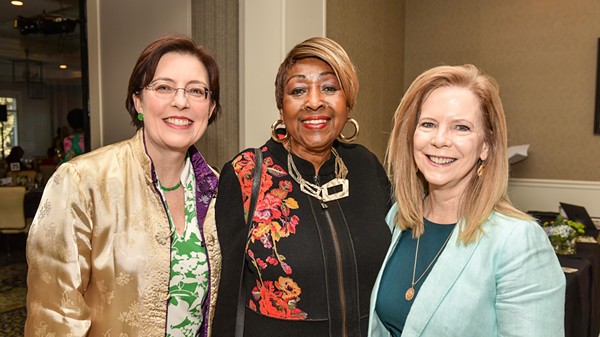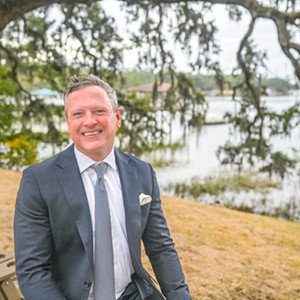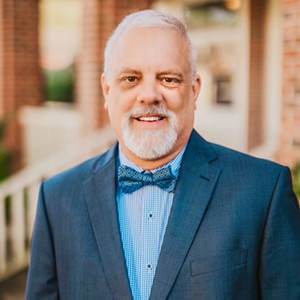Every morning an employee of the City of Savannah drives 75 miles upriver to a bridge on Highway 301 outside Sylvania, to catch a water sample of the Savannah River. The sample is brought back to the Savannah Water Treatment & Supply Plant where it is tested for elevated levels of radioactivity.
Why do this? “That’s our early warning system,” says Willy Weil, an administrator at the water plant.
Weil says their testing system would give Savannah about 90 hours to act before the contaminated water flows into the lower river basin where the city draws 35 million gallons a day to supply drinking water to Pooler, Port Wentworth and Effingham County.
Why test for radioactivity? Savannah is 130 miles downstream of the Savannah River Site (SRS), a Department of Energy nuclear facility that manufactured almost half of the nuclear weapons built during the Cold War.
A study by the Institute for Energy and Environmental Research (IEER), a nuclear think tank, reports, “The Savannah River Site contains the largest amount of radioactivity in waste of any nuclear weapons site in the United States.”
SRS records show leaks of radioactive material into the river beginning in 1960 when environmental monitoring first began. Radioactive leaks and intentional releases continue to this day.
Downstream, at Savannah’s water treatment plant, raw river water is a yellow-brown before it is filtered and treated with chlorine. The “finished” water is as clear as a bottle of Evian.
But looks can be deceiving. This crystal-clear water contains the same amount of radioactive material as the raw river water. Conventional treatment plants like Savannah’s simply can’t remediate radiation from the water.
The most ubiquitous radioactive material in the river is called tritium, a low level radionuclide used as a yield booster in all U.S. nuclear warheads. Now it’s in the drinking water for 150,000 people in Georgia and South Carolina.
This past year, smaller tritium leaks in other parts of the country has invoked outrage, fear and a second look at what constitutes a safe standard of radioactivity in drinking water.
The director of the Water Treatment and Supply Plant, John Sawyer, says that under the new Coastal Water Plan, “Nobody is getting any additional groundwater” from the Floridan Aquifer, currently supplying water to the city of Savannah and Chatham County. But as the region grows, additional water will have to come from somewhere -- and that somewhere will be the Savannah River.
Do I drink the water?
Dr. Richard Lee, professor and radiation safety officer at the Skidaway Institute of Oceanography says that there is absolutely no problem drinking tritium-laced water. “Of all the radioactive material, it is the least harmful,” he says.
But he goes on to say that if you look into the history of how allowable levels of radioactive compounds in drinking water were set, “you’ll find that they were pretty arbitrary.”
States like California are reexamining the EPA limit of allowable tritium in drinking water, which currently is 20,000 picocuries per liter (pCi/L) of water. California set a public health goal of no more than 500 pCi/L (curies are a measure of radioactivity) of tritium in drinking water -- a level the state says can still cause one cancer per million of people exposed.
A recent tritium leak at a California nuclear power plant caused the city of San Clemente to shut down a city well for fear of contamination.
Another tritium leak discovered this year at a nuclear power plant in Braidwood, Ill., resulted in public outcry and three civil lawsuits. Tritium contamination was found in one private well at levels well below drinking water standards, yet the Illinois power company continues to supply bottled drinking water to two nearby communities and engage in outreach and remediation plans.
The tritium leaking into the ground at the Savannah River Site is three to four hundred times greater than the isolated leak in San Clemente, which was quickly pumped from groundwater beneath the power plant without any contamination to the city’s water system.
According to John Sawyer, Savannah River water averages 1000 picocuries of tritium per liter of water -- five percent of the EPA’s Maximum Contaminate level but twice the health goal set by California.
Dr. Lee, John Sawyer and most of the nuclear industry agree that radiation from manufactured tritium is a small portion of a person’s overall radiation uptake. It is often likened to the “background” radiation -- or naturally occurring radiation -- that is unavoidable anywhere on earth.
‘Nonsense’
But Dr. Arjun Makhijani, director of Institute for Energy and Environmental Research, calls this “nonsense” and “a bogus argument.”
Dr. Makhijani explains that naturally occurring radiation doesn’t penetrate the human body like a glassful of consumed tritiated water, which he says, “can cause damage inside cells and cross the placenta of a pregnant woman.” His study linking tritium exposure to miscarriages is due out in the coming months.
Furthering his claims, the Argonne National Laboratory says, “tritium poses a health hazard only if it is taken into the body.” Studied effects of chronic low-level exposure to radiation include, cancer, genetic mutations and effects on fetuses.
At the very least, the Savannah River Site should take the lead of Colorado, Makhijani says. The Department of Energy’s nuclear facility in Rocky Flats, Colo., agreed to a state regulation requiring cleanup if more than 500 picocuries of tritium is found in surface water.
When we asked SRS if they would consider that same limit, the answer was simply, “No.”
The SRS 2004 Environmental Report reveals that it would be next to impossible for them to meet a 500 picocurie limit. In that year, SRS released 2,785 trillion picocuries of tritium into the Savannah River by direct release and seepage from the ground. The year before that 4,319 trillion picocuries were released.
In his report “Nuclear Dumps by the Riverside,” Makhijani says that the DOE’s “habit of operating in secret outside of independent scrutiny,” is threatening the long-term health of the Savannah River.
In a House Report Bill, Congress called the DOE’s current system of managing environmental, safety and health an “ad hoc process; there is inadequate discipline.” The report goes on to say, “there is no agreement on what it means to be safe.”
Harry Jue, Savannah’s director of Water and Sewer, agrees. He says that because of the exemption from federal environmental laws, DOE sites are in general “some of the worst hazardous waste sites in the country because people were sloppy.”
The recent tritium leaks at nuclear power plants fall under the jurisdiction of the Nuclear Regulatory Commission (NRC), which finished a task force study on the recent spate of leaks and is due out with recommendations any day. Scott Burnell, a public affairs officer at NRC, says the findings could lead to recommendations, which often lead to tighter regulations. But, he says, NRC wouldn’t have any power to regulate SRS to tighter standards.
Because SRS is a Department of Energy facility, it is not beholden to any other regulatory agency. It is entirely self-regulated. This self-regulation has netted the DOE fifteen spots, including the Savannah River Site, on the Superfund National Priority List.
Tritium is by far the most abundant radioactive contaminate at SRS, but it is far from the most dangerous. There are 34 million gallons of high-level radioactive waste stored in 49 underground tanks. Leaks have been discovered in one of the tanks, which the Secretary of Energy calls a “symptom of a much larger problem.”
This past year the Defense Nuclear Safety Board reported multiple leaks, drill failures, violations and procedure errors at Savannah River Site. Among the stated concerns were “lack of knowledge,” “miscommunication,” “inadequate procedures,” and “misunderstandings.”
The management of Savannah River Site is contracted to Westinghouse. In January of this year, the DOE levied a $300,000 fee reduction at Westinghouse for “unsatisfactory performance.”
Westinghouse will be managing the removal of the high level nuclear waste from the leaking tanks and John Sawyer wonders if that poses a threat. “Do you wait for another 20, 30, 40, 50 years to develop some way to handle this, and let it leak, or do you fix it? And who do you believe?”
Sawyer says “I’m not taking anybody’s side, but it just seems like common sense to me to get as much of that stuff out of there as you can get out of there. Now.”
Since the DOE did not renew a grant that provided funding to the Georgia Environmental Protection Department for radionuclide testing in the river, monitoring of daily radioactivity levels in drinking water falls largely on the Savannah Water Treatment Plant.
If a large radioactive leak were to occur, Weil says the plant would shut down or issue a “Don’t drink the water” public warning.
Postscript
The morning I was at the Savannah water plant, it was a bright late summer day. A deep well with a tile mosaic bottom in the image of the Savannah crest was filled with a column of finished Savannah River water as clear as vodka.
“It’s good water,” says Weil.
Before I left I poured myself a tall glass and drank it before heading back outside. ç
Stacey Kronquest is a local freelance writer. To comment, e-mail us at
[email protected]



